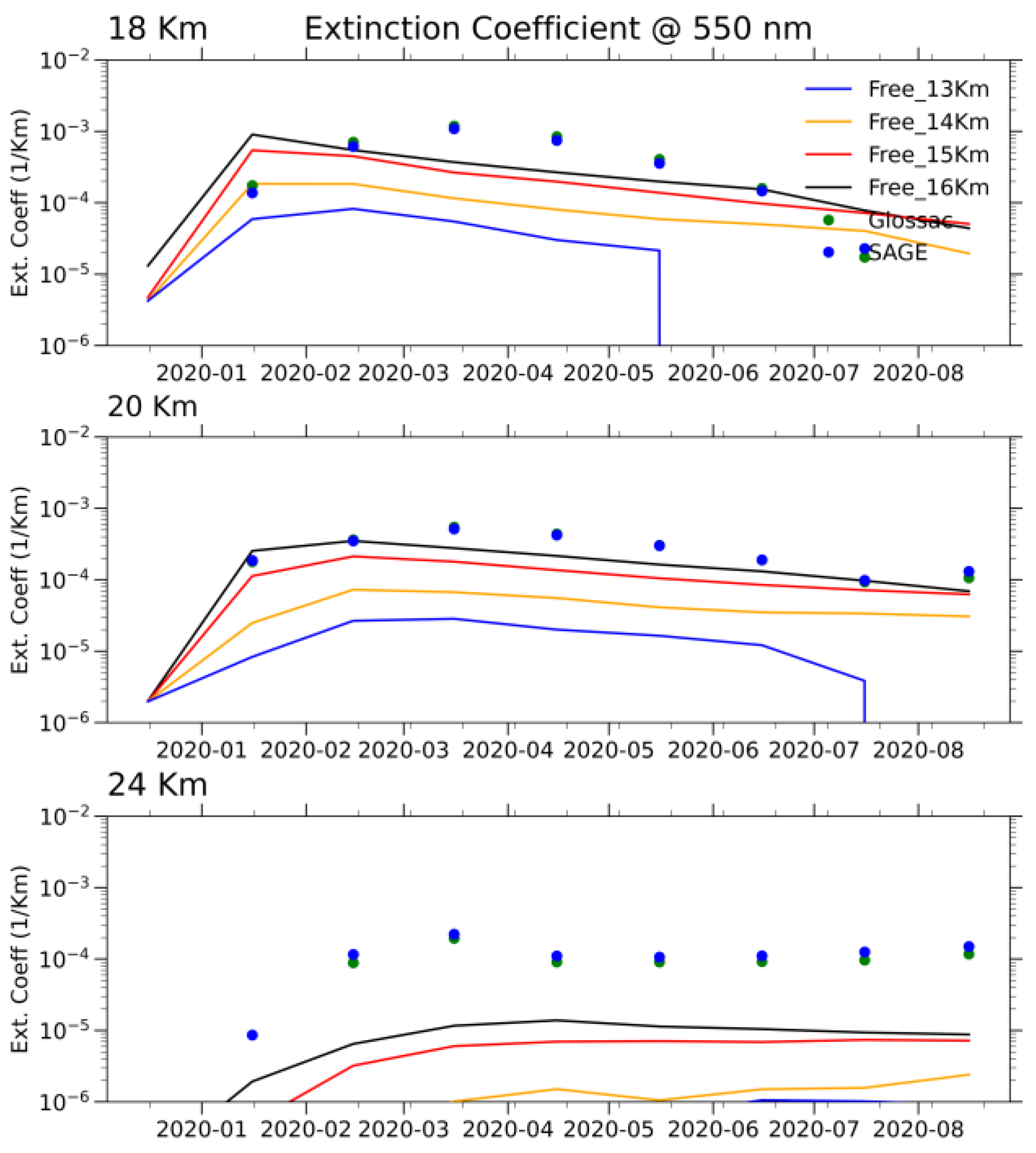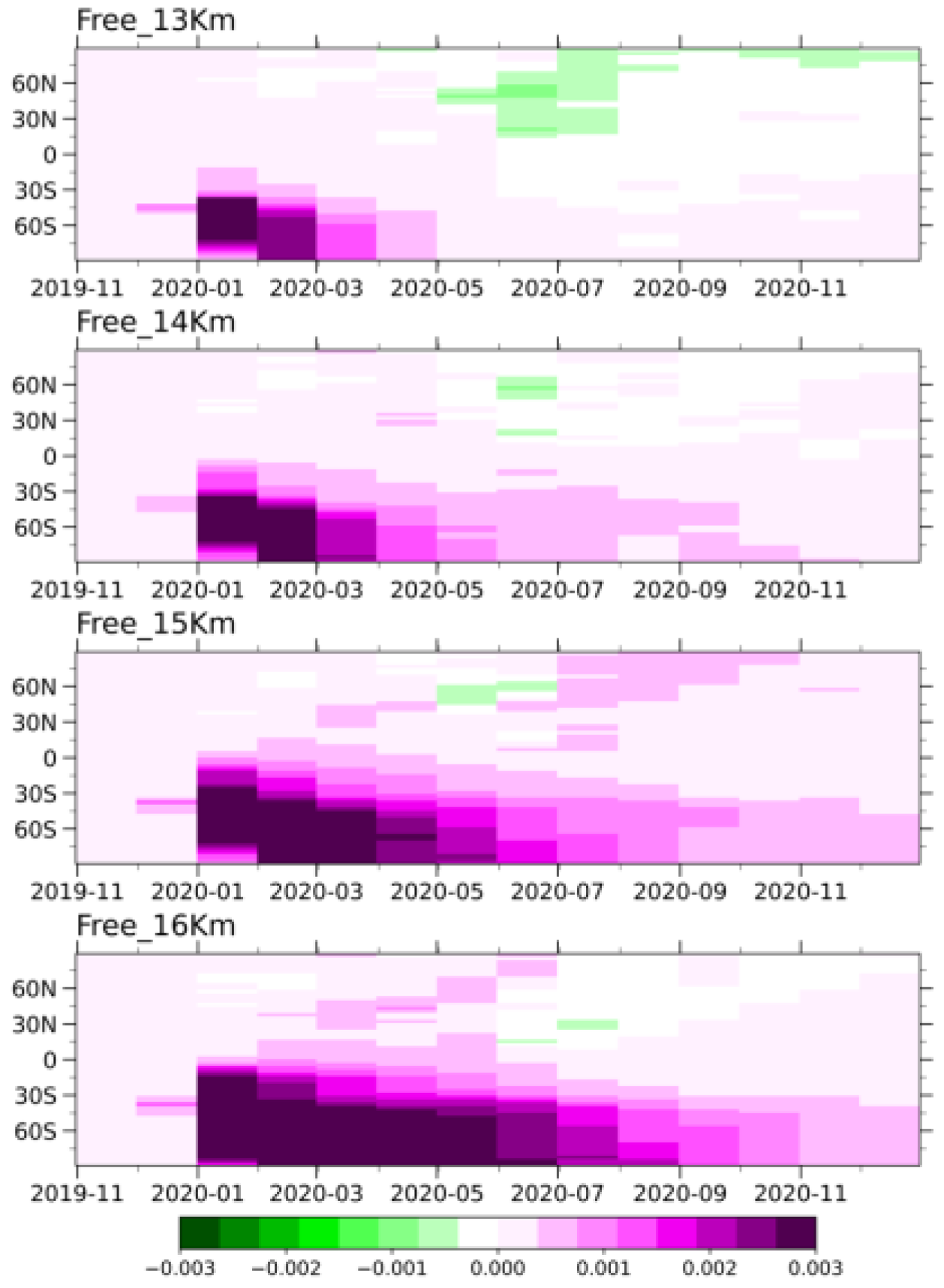1. Introduction
Large-scale wildfires have been making global headlines over the recent years, highlighting the importance of fire and its feedback within the Earth system. The most extreme manifestation of a fire–weather interaction is the formation of pyrocumulonimbus (pyroCb) clouds. PyroCbs are thunderstorm-like clouds developed by powerful wildfires under favorable meteorological conditions. Observations over the last years highlight that: (a) pyroCbs are surprisingly frequent in the mid-latitude summer, (b) pyroCbs can inject as much smoke, water, and reactive gases into the stratosphere as volcanic eruptions, (c) without fast removal in the stratosphere, the smoke flies high for months and spreads over the globe, and (d) a warming climate favors more frequent and severe smoke injections [
1,
2,
3]. PyroCb firestorms have thus emerged as new semi-seasonal source of aerosols in the stratosphere.
Smoke is largely composed of organic and black carbon, numerous reactive gases, and other aerosol precursors. Black carbon (BC) is of particular interest as it is the strongest absorber of shortwave light. Absorption by BC heats the plume causing shelf-lofting to higher altitudes, which prolongs the smoke lifetime and amplifies radiative and chemical perturbations [
3,
4]. The global and regional radiative effects and feedbacks associated with stratospheric smoke are uncertain, partly because smoke aging in the stratosphere is not well constrained. Apart from radiative perturbations, smoke may also accelerate ozone destruction via (a) heterogeneous chlorine chemistry, (b) moistened stratosphere and water vapor photolysis, (c) chlorine activation on polar stratospheric clouds (PSCs), and (d) changes in circulation [
5]. These mechanisms are known from studies of volcanic aerosols, but their chemical reactivity might differ for smoke, given the different nature of smoke aerosols.
These recent developments call for a comprehensive characterization of the multi-faced role of smoke to the variability of the lower stratosphere and the global climate. StratoFIRE is aiming exactly at reducing some of those uncertainties. StratoFIRE is an ELIDEK project running from 2022 to 2025 to provide evidence that the lower stratosphere may act as a mediator connecting extreme wildfires, smoke, and global climate. In the three years of this project, we aim to (i) monitor stratospheric smoke with a variety of ground-based and space-borne instruments, with particular emphasis given to continuous measurements at the PANGEA observatory (PANhellenic GEophysical Observatory of Antikythera), (ii) develop novel methodologies to infer emissions, optical properties and lifetime of smoke and quantify its corresponding radiative forcing, and (iii) apply this new information to global climate models to assess the climatic relevance of the stratospheric smoke intrusions.
2. The Australian New Year Wildfires
The largest known stratospheric smoke injection was associated with the fierce Australian wildfires in the New Year of 2019/2020 (ANY hereafter). Many pyroCbs injected over 1 million tons of smoke particles into the stratosphere, reaching altitudes up to 35 Km. The mass and reach of this aerosol injection exceeded all volcanic aerosol injections over the last 30 years. Satellite- and ground-based measurements subsequently detected self-lofting, significant stratospheric warming, and a considerable reduction in mid-latitude ozone that lasted several months. During November–December 2020, the Antarctic ozone hole reached a decadal high in magnitude and persistence, along with record-low polar temperatures and a strong polar vortex. The magnitude of the record-high ozone depletion event in 2020 corresponds to a ~10-year delay in ozone recovery.
3. Model Simulations of the Australian New Year Wildfires
Wildfires need to be investigated with respect to their relation to weather, climate, and society. Herein, we used the EMAC Earth System Model to simulate atmospheric and climatic responses to the ANY wildfires [
6]. The model was configured with (a) aerosol microphysics, (b) chemistry with heterogenous reactions, (c) a scheme for PSCs, and (d) comprehensive chemistry–radiation–dynamics interactions. EMAC links together all the key mechanisms between the stratosphere and surface, which makes it possible to quantify how stratospheric smoke affects the global radiative balance, circulation, ozone concentrations, surface UV levels, and precipitation patterns.
As a first step, we carried out sensitivity simulations to examine the sensitivity of the stratospheric aerosol loading to the injection height of the smoke (
Table 1). The model is running with nudged meteorology from ERA5 till 28 December 2019 and freely thereafter till the end of 2020. We emitted 0.9 Tg of smoke composed of 97.5% organic carbon and 25% black carbon. The particles were emitted in the insoluble Aitken mode.
Figure 1 shows aerosol extinction coefficients (1/Km) averaged from 20° S to 60° S at 14, 18, and 22 Km. Superimposed in dots are extinction coefficients from the monthly mean GLOSSAC merged aerosol dataset and SAGE-ISS observations. Our model generally showed a faster increase in the extinction coefficients in the first months after the ANY pyroCbs whether observations indicate a more gradual buildup, peaking in March 2020. Similar behavior is simulated at 20 Km. At 24 Km, the model considerably underestimated the magnitude of the aerosol extinction by the injected smoke in all sensitivity runs. Regarding the emission height, we found that a maximum injection of smoke at 16 Km yielded the best similarity to the observed extinction.
Figure 2 compares the time evolution of the stratospheric aerosol optical depth (SAOD) from the ANY wildfires assuming different emission heights. We found that an injection height of 13 Km perturbs aerosols in the stratosphere for 5 months only. In contrast, an injection at 16 Km height causes an aerosol perturbation in both hemispheres. In the Southern Hemisphere, SAOD was perturbed even in the following year with values above 0.001. Interestingly, smoke penetrates the Northern Hemisphere and reaches the Arctic in June–July 2020.
4. Summary
In the first set of simulations presented here, we examined the sensitivity of the SAOD to the injection height of the smoke plume. The best agreement with observations was found by assuming a maximum injection height of 16 Km. The next step will be to quantify the radiative perturbations in the stratosphere and the global radiative forcing after ANY. Smoke, however, presents rather different properties from the liquid, spherical, less light-absorbing sulfuric acid droplets of volcanic origin that are usually found at stratospheric altitudes. StratoFIRE will explore a detailed characterization of the optical and microphysical properties of stratospheric smoke, which at present remain poorly understood mainly due to the sparsity of the remote sensing/in situ observations in the LS [
7]. This uncertainty complicates considerably any assessment of the radiative impacts of stratospheric smoke.
Author Contributions
Conceptualization, S.M., K.T. and V.A.; formal analysis, S.M. and A.C.; writing—review and editing, S.M., A.C., K.T. and V.A.; All authors have read and agreed to the published version of the manuscript.
Funding
This work has been funded by the 2nd Call for H.F.R.I.’s Research Projects to Support Faculty Members & Researchers (Project Acronym: STRATOFIRE, Project Number: 3995).
Institutional Review Board Statement
Not applicable.
Informed Consent Statement
Not applicable.
Data Availability Statement
All data and codes are available upon request.
Conflicts of Interest
The authors declare no conflict of interest.
References
- Fromm, M.; Servranckx, R.; Stocks, B.J.; Peterson, D.A. Understanding the critical elements of the pyrocumulonimbus storm sparked by high-intensity wildland fire. Commun. Earth Environ. 2022, 3, 243. [Google Scholar] [CrossRef]
- Peterson, D.A.; Campbell, J.R.; Hyer, E.J.; Fromm, M.D.; Kablick, G.P.; Cossuth, J.H.; DeLand, M.T. Wildfire-driven thunderstorms cause a volcano-like stratospheric injection of smoke. Npj Clim. Atmos. Sci. 2018, 1, 30. [Google Scholar] [CrossRef] [PubMed]
- Yu, P.F.; Davis, S.M.; Toon, O.B.; Portmann, R.W.; Bardeen, C.G.; Barnes, J.E.; Telg, H.; Maloney, C.; Rosenlof, K.H. Persistent Stratospheric Warming Due to 2019-2020 Australian Wildfire Smoke. Geophys. Res. Lett. 2021, 48, e2021GL092609. [Google Scholar] [CrossRef]
- Yu, P.F.; Toon, O.B.; Bardeen, C.G.; Zhu, Y.Q.; Rosenlof, K.H.; Portmann, R.W.; Thornberry, T.D.; Gao, R.S.; Davis, S.M.; Wolf, E.T.; et al. Black carbon lofts wildfire smoke high into the stratosphere to form a persistent plume. Science 2019, 365, 587–590. [Google Scholar] [CrossRef]
- Solomon, S.; Dube, K.; Stone, K.; Yu, P.; Kinnison, D.; Toon, O.B.; Strahan, S.E.; Rosenlof, K.H.; Portmann, R.; Davis, S.; et al. On the stratospheric chemistry of midlatitude wildfire smoke. Proc. Natl. Acad. Sci. USA 2022, 119, e2117325119. [Google Scholar] [CrossRef]
- Jöckel, P.; Kerkweg, A.; Pozzer, A.; Sander, R.; Tost, H.; Riede, H.; Baumgaertner, A.; Gromov, S.; Kern, B. Development cycle 2 of the Modular Earth Submodel System (MESSy2). Geosci. Model Dev. 2010, 3, 717–752. [Google Scholar] [CrossRef]
- Gialitaki, A.; Tsekeri, A.; Amiridis, V.; Ceolato, R.; Paulien, L.; Kampouri, A.; Gkikas, A.; Solomos, S.; Marinou, E.; Haarig, M.; et al. Is the near-spherical shape the “new black” for smoke? Atmos. Chem. Phys. Discuss. 2020, 2020, 1–29. [Google Scholar] [CrossRef]
| Disclaimer/Publisher’s Note: The statements, opinions and data contained in all publications are solely those of the individual author(s) and contributor(s) and not of MDPI and/or the editor(s). MDPI and/or the editor(s) disclaim responsibility for any injury to people or property resulting from any ideas, methods, instructions or products referred to in the content. |
© 2023 by the authors. Licensee MDPI, Basel, Switzerland. This article is an open access article distributed under the terms and conditions of the Creative Commons Attribution (CC BY) license (https://creativecommons.org/licenses/by/4.0/).








